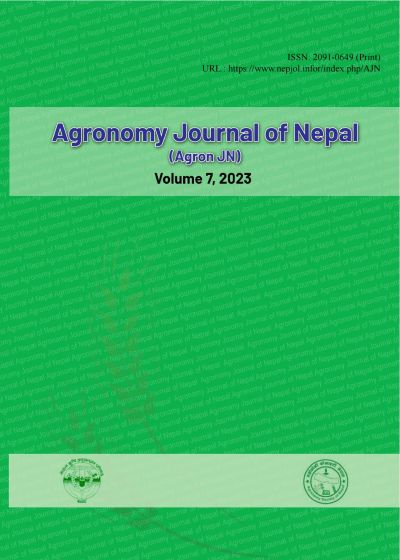Effect of Different Herbicides in Weed Management in Transplanted Rice
DOI:
https://doi.org/10.3126/ajn.v7i1.62166Keywords:
Pretilachlo, management, rice, weed, yieldAbstract
Weed is one of the major yield-limiting factors in rice cultivation. It causes yield losses of around 40-90%, depending on the situation. Manual weeding is the dominant weed management method in rice and limited farmers use herbicides in Nepal. Selecting effective herbicides for different weed species is a crucial task for farmers. So, an experiment with 9 treatments consisting of 5 herbicides was conducted in RCB Design with 3 replications during 2020 and 2021 to find effective herbicides. The recommended agronomic practices were followed. Rice variety Khumal 11 was transplanted in a 4m x 3m plot with a spacing of 20 cm between rows and 15 cm between plants. Pooled data of two years showed the lowest weed density (14.2 m-2) and highest (73.2 m-2) in the treatment pretilachlor @ 0.5 kg ha-1 (pre) as sand mix and in the weedy check. Similarly, the lowest weed dry biomass (7.4 g m-2) and the highest (42.4 g-2) were recorded in the same treatments. The grain yield was the highest (7253 kg ha-1) in pretilachlor applied at 0.5 kg a.i ha-1 as pre-emergence spray and the lowest (4339 kg ha-1) in the control. The treatment pretilachlor @ 0.5 kg a.i ha-1 (pre) applied as spray was superior in managing weed and resulting in the highest grain yield, so it is recommended for mid-hill ecologies under transplanted rice.
Downloads
Downloads
Published
How to Cite
Issue
Section
License
Copyright (c) 2023 Agronomy Society of Nepal (ASoN)

This work is licensed under a Creative Commons Attribution-NonCommercial 4.0 International License.
ASON permits for free use, distribution and reproduction in any medium if the original work is properly cited and not used for commercial purposes.




